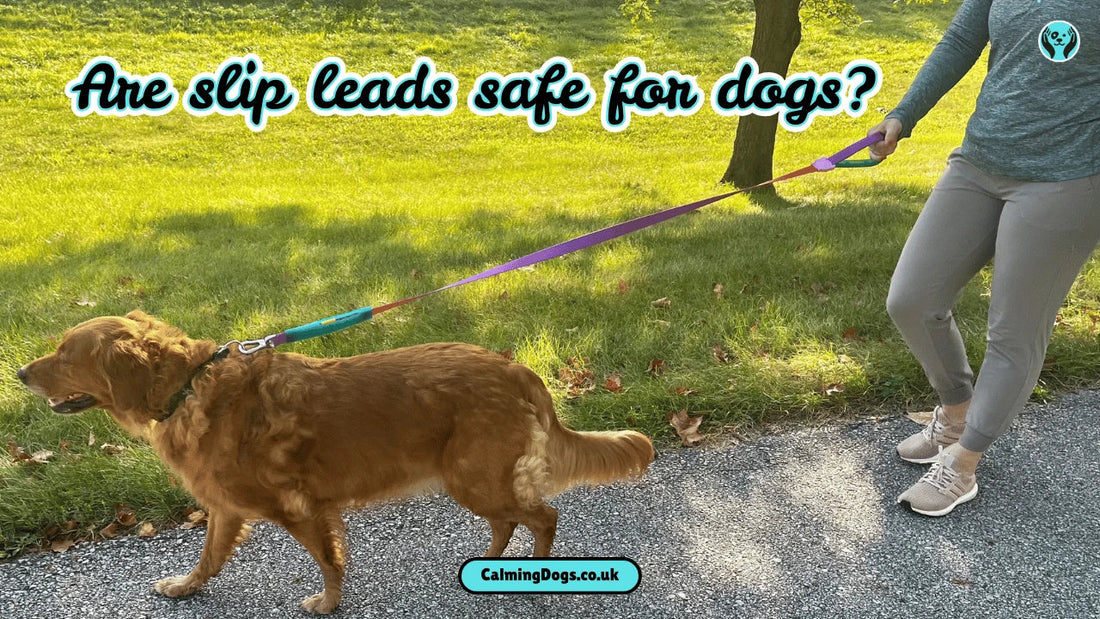
Are Slip Leads Safe for Dogs?
Introduction
Imagine you are at the dog park, another dog owner, confidently walking their dogs around the park using a beautiful looped leash.
In the meantime, you’re struggling with a harness that has more tangles than an earbud wire and thinking, “Would a slip lead make walks easier or is that dangerous, too?”

Dog owners also split by a handful of slip leads — alternative such a thing. Despite their apparent simplicity and the praise it has received for this, safety doubts remain.
This article delves into the core of the issue, Are slip leads dog safe? Looking at their advantages and disadvantages, the expert opinions so that you will be able to determine whether this tool is suitable for your dog.
What is a Slip Lead?
A slip lead combines a leash and collar into one adjustable loop. Made from nylon, rope, or leather, it tightens gently around a dog’s neck when tension is applied and loosens when slack is given.
Unlike traditional collars, it lacks a buckle or clip, relying on a sliding mechanism for control.
Common Uses:
● Training: Trainers often use slip leads for teaching loose-leash walking.
● Quick Control: Ideal for vet visits or grooming where speed is key.
● Experienced Handlers: Popular among professionals for dogs that respond to subtle cues.
Best 3 Comfortable Dog Collars to Buy

Pros and Cons of Slip Leads
Let’s break down the advantages and risks objectively:
| Pros | Cons |
|---|---|
| ● Lightweight & Portable | ● Risk of Choking |
| Easy to carry and quick to put on. | Tightens under pressure; overuse can injure the trachea. |
| ● Instant Feedback | ● Improper Use Harmful |
| Helps correct pulling immediately. | Jerking or harsh handling can cause neck strain. |
| ● Training Aid | ● Not for All Dogs |
| Encourages focus on leash tension. | Unsafe for puppies, small breeds, or dogs with respiratory issues. |
Are Slip Leads Safe for Dogs?
Safety hinges on how, when, and for whom slip leads are used.
When They Can Work:
● Trained Dogs: Dogs conditioned to respond to gentle pressure.
● Short-Term Control: For brief, supervised scenarios (e.g., vet exams).
● Experienced Handlers: Owners who understand leash mechanics and avoid yanking.
When They’re Risky:
● Puppies: Delicate necks and impulsive behavior increase injury risk.
● Strong Pullers: Dogs that lunge may choke themselves.
● Brachycephalic Breeds: Pugs, Bulldogs, and similar breeds face higher respiratory risks.

When to Use and When to Avoid
Use a Slip Lead If:
● Your dog knows loose-leash walking basics.
● You’re in a controlled environment (e.g., training class).
● Your dog is medium/large-sized with no neck issues.
Avoid a Slip Lead If:
● Your dog is a puppy, reactive, or has a short muzzle.
● You’re inexperienced with slip lead techniques.
● Your dog has a history of tracheal collapse or spinal problems.
Expert Recommendations
Trainers’ Take:
Slip leads are endorsed by a lot of trainers in the right hands for teaching polite leash manners. The trick is to use them with reinforcers and not punishers.
Veterinary Advice:
Slip leads are particularly suggested against in dogs likely to hurt their necks, which is where vets often recommend against their use.
Canine physiotherapist Dr Sarah Mitchell says: "Continual pressure on the throat can cause permanent damage. Always opt for harness —Especially perpetual pullers.
Alternatives to Slip Leads
1) Harnesses: Distribute pressure across the chest—ideal for pullers or small dogs.
2) Martingale Collars: Tighten slightly to prevent escape without choking (great for Greyhounds).
3) Front-Clip Harnesses: Redirects pulling momentum sideways.
Choose Alternatives When:
● Your dog is still learning leash etiquette.
● You want to minimize neck strain.
● Your dog is reactive or easily overstimulated.
Frequently Asked Question (FAQs)
1. Are rope slip leads safe for dogs?
Yes, if made from soft, non-abrasive material and used gently. Avoid thin ropes that dig into the skin.
2. Are slip leads dangerous for dogs?
They can be if misused. However, correct fit and technique are are essential; never leave a slip lead on unattended.
3. Are slip leads illegal in the UK?
Animal Welfare Act 2006 requires humane tools, however, so no. Any misuse resulting in harm may result in criminal liability.
4. Are slip leads good for reactive dogs?
Usually not, but risk lunging and can cause injury_Handler poles in front of the dog. Choose a harness with a front attachment.
5. Are slip leads cruel for puppies?
Yes. Puppies’ fragile necks and lack of training make slip leads a poor choice. Use a flat collar or harness.
6. Do vets recommend slip leads?
Most vets prefer harnesses, but some approve of slip leads for brief, controlled use with trained dogs.
Conclusion
Slip leads are not naturally good or bad, but they are good if you know how to use them and there are some cases that are ideal for slip leads. They are simple and precise for disciplined dogs and savvy handlers.
Alternatives, like Harnesses, are often a better fit for puppies, pullers, and at-risk breeds. Put your dog first, see a trainer if in doubt, and remember: The best implement is one that keep both you and your dog calm and safe on walks.